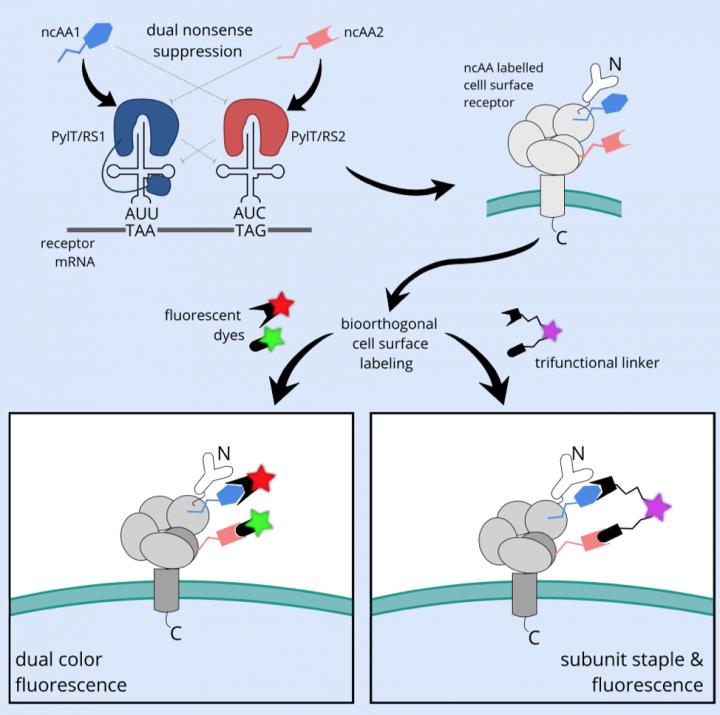Illuminating cell surface receptors

Site-specific incorporation of two noncanonical amino acids for two-color bioorthogonal labeling and crosslinking of proteins on live mammalian cells Credit: Simon Elsässer
Birthe Meineke and Johannes Heimgärtner have jointly developed a method in Simon Elsässer's lab at Science For Life Laboratory Stockholm to label and image receptors on live cells with two different colors.
Unlike existing live-cell microscopy methods, which typically rely on sizeable fluorescent proteins fused to the receptor, here only two amino acids in the receptor of interest are exchanged for noncanonical amino acids.
These two synthetic building blocks act as chemical handles, each compatible with a different fluorescent dye, using so-called bioorthogonal chemistry.
The method allows for two differently colored dyes to be installed on live cells in almost any position of the receptor. Hence, fluorescent assays can be developed that not only read out the localization of the receptor, but also report on conformational changes involved in sensing the environment and transducing extracellular signals to the cells' interior.
Many receptors, such as the large family of G-protein coupled receptors, are important drug targets. Mechanistic insight into the action of drugs on those receptors has so far predominantly been collected on purified receptors in an in vitro environment.
The new method, successfully demonstrated by the team on a G-protein coupled receptor and a Notch receptor, expands the possibilities to study natural behavior and pharmacology of receptors in their native setting in the membrane of live cells.
###
The study was funded by Karolinska Institutet/Science for Life Laboratory SFO in Molecular Biosciences, Vetenskapsrådet (2015-04815), Ming Wai Lau Center for Reparative Medicine, Ragnar Söderbergs Stiftelse, Knut och Alice Wallenbergs Stiftelse (2017.0276)
Media Contact
More Information:
http://dx.doi.org/10.1016/j.celrep.2020.107811All latest news from the category: Life Sciences and Chemistry
Articles and reports from the Life Sciences and chemistry area deal with applied and basic research into modern biology, chemistry and human medicine.
Valuable information can be found on a range of life sciences fields including bacteriology, biochemistry, bionics, bioinformatics, biophysics, biotechnology, genetics, geobotany, human biology, marine biology, microbiology, molecular biology, cellular biology, zoology, bioinorganic chemistry, microchemistry and environmental chemistry.
Newest articles

High-energy-density aqueous battery based on halogen multi-electron transfer
Traditional non-aqueous lithium-ion batteries have a high energy density, but their safety is compromised due to the flammable organic electrolytes they utilize. Aqueous batteries use water as the solvent for…

First-ever combined heart pump and pig kidney transplant
…gives new hope to patient with terminal illness. Surgeons at NYU Langone Health performed the first-ever combined mechanical heart pump and gene-edited pig kidney transplant surgery in a 54-year-old woman…

Biophysics: Testing how well biomarkers work
LMU researchers have developed a method to determine how reliably target proteins can be labeled using super-resolution fluorescence microscopy. Modern microscopy techniques make it possible to examine the inner workings…





















